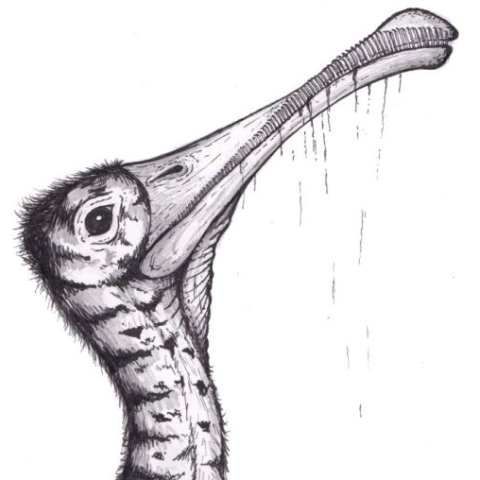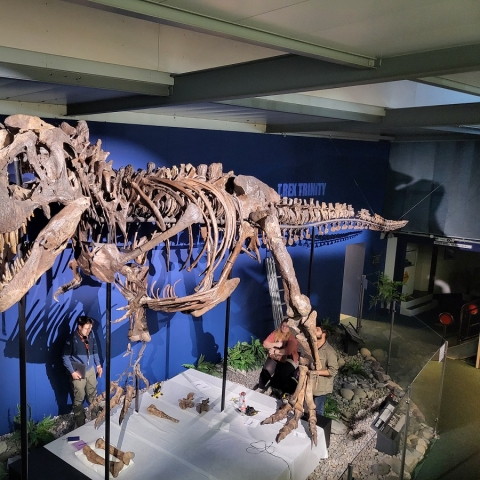

The discovery of fossilised stomach contents in two pterosaur species provides new insights into their diet and feeding behaviour
23 October 2024
6 min read
The first-ever discovery of fossilised stomach contents in two 182-million-year-old flying reptile fossils provides palaeontologists with important clues about pterosaur diet and ecology.
Pterosaurs ruled the skies during the age of the dinosaurs. Over millions of years, they evolved into an enormous variety of forms, including giant species with wingspans of up to 12 metres.
But little is known about how and what these pterosaurs ate. The spectacular discovery of fossilised stomach contents in two pterosaur species, Dorygnathus and Campylognathoides, from the Early Jurassic of Southwest-Germany has provided new insights into their diet and feeding behaviour.

The examined fossil of the pterosaur Dorygnathus. Small fish bones can be found in the fossilised stomach contents of the animal.
Copyright: SMNS, S. Cooper
Dr Samuel Cooper, a palaeontologist at the State Museum of Natural History Stuttgart, examined the fossils and analysed the remains in the reptiles' stomachs together with colleagues from the University of Portsmouth in the UK; Professor David Martill and Dr Roy Smith.
The results, published in the Journal of Vertebrate Paleontology, show that the pterosaur Dorygnathus ate small fish, while Campylognathoides ate prehistoric squid. This oldest and world's first clear evidence of squid consumption in pterosaurs tells researchers a lot about the animals' lifestyle, ecology and evolution.
The specimens of Dorygnathus and Campylognathoides, which are around 182 million years old, come from the Posidonia Shale in the region around Holzmaden in Baden-Württemberg in Germany. Until now, nothing was known about the diet of pterosaurs from this period.

Reconstruction of an Early Jurassic habitat in Southwest-Germany. The pterosaur Dorygnathus fed on small fish, as shown by the fossil stomach contents.
Copyright: SMNS, L. Reinöhl.
Dr Roy Smith, from the University’s School of Environment and Life Sciences, said: “It is incredibly rare to find 180 million-year-old pterosaurs preserved with their stomach contents, and provides ‘smoking gun’ evidence for pterosaur diets. The discovery offers a unique and fascinating glimpse into how these ancient creatures lived, what they ate, and the ecosystems they thrived in millions of years ago.”
The remarkable find is the first evidence of different diets of two different pterosaur species in the same environment.
Dr Samuel Cooper, first author of the study, said: “The fossilised stomach contents tell us a lot about the ecosystem at that time and how the animals interacted with each other. For me, this evidence of squid remains in the stomach of Campylognathoides is therefore particularly exciting. Until now, we tended to assume that it fed on fish, similar to Dorygnathus, in which we found small fish bones as stomach contents.
It is incredibly rare to find 180 million-year-old pterosaurs preserved with their stomach contents, and provides ‘smoking gun’ evidence for pterosaur diets.
Dr Roy Smith, Lecturer
“The fact that these two pterosaur species ate different prey shows that they were likely specialised for different diets. This allowed Dorygnathus and Campylognathoides to coexist in the same habitat without much competition for food between the two species.”
Fossil stomach contents representing the last meal of these animals are extremely rare. This is probably because pterosaurs digested their food very quickly, as the extra weight in their stomachs would have affected their ability to fly. Dorygnathus and Campylognathoides were similar to modern seabirds. They flew over the water of a warm, subtropical sea that flooded South-Germany during the Jurassic period and was their food source.
The two pterosaurs studied are part of the extensive palaeontological collections of the State Museum of Natural History Stuttgart. As part of a research project on the “Palaeobiology of Vertebrates in the Posidonia Shale” the museum has re-examined numerous fossils from this period. During this research, the stomach contents of the two pterosaurs were discovered.

Illustration of the pterosaur Campylognathoides hunting squid.
Copyright: Samuel Cooper
The Posidonia Shale is an approximately 182-year-old black shale formation in Southwest Germany that is known for its exceptionally well-preserved and diverse fossils. The fossil fauna of this period includes a wide variety of animals, including pregnant ichthyosaurs with preserved embryos, long-necked plesiosaurs, marine crocodiles, various large fish, crustaceans, cuttlefish, ammonites and pterosaurs.
Together they provide one of the most comprehensive and unique snapshots of early Jurassic marine life. Fossilised soft parts, such as stomach contents or skin, are very rare because they can only be preserved under special environmental conditions. The seabed of the Posidonia Shale was low in oxygen, which resulted in good preservation conditions. In addition, the very soft mud ensured that dead animals sank quickly into the mud without scavengers or water currents destroying their remains.
The squid-eating pterosaur Campylognathoides can be seen by visitors in the permanent exhibition of the State Museum of Natural History Stuttgart in the Museum am Löwentor.
You might also like...
Research reveals the most complete dinosaur discovered in the UK in a Century
The most complete dinosaur discovered in this country in the last 100 years, with a pubic hip bone the size of a ‘dinner plate’, has been described in a new paper published today.
10 July 2024
6 min read

Gigantic Jurassic pterosaur fossil unearthed in Oxfordshire
A team of palaeontologists has discovered a fossil of a gigantic flying reptile from the Jurassic period with an estimated wingspan of more than three metres - making it one of the largest pterosaurs ever found from that era.
3 June 2024
4 min read

Portsmouth-based team lead scientific work on the multimillion-dollar T. rex skeleton ‘Trinity’
12 April 2024
3 minutes

